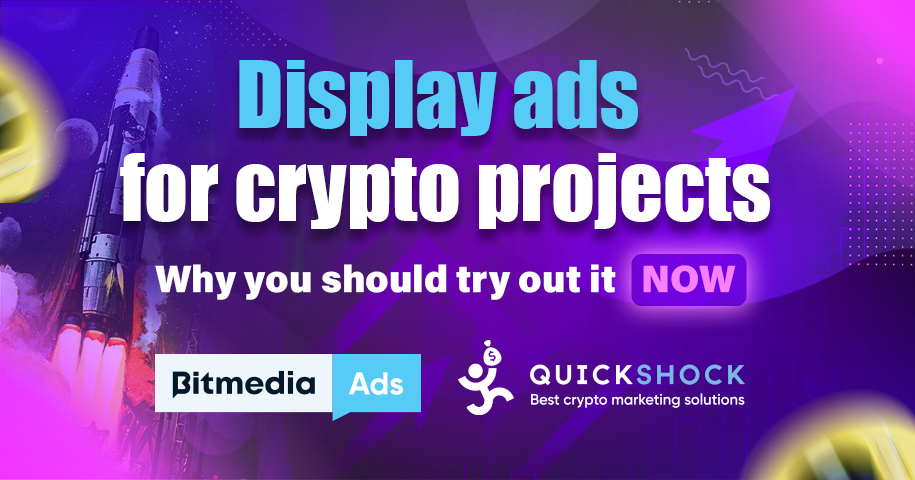Crypto Display Ads vs. Influencer Marketing – Which Delivers Better ROI?

Some crypto projects become popular overnight, while others, with the same tech and budget, fail. The difference lies in one key thing: how and where they spend their marketing budget.
The crypto world isn’t exactly known for playing by the rules. With ad bans, platform restrictions, and a skeptical audience, marketers have to be creative to survive and smarter if they want to thrive. The real question is whether crypto display ads or influencer marketing are more effective when it comes to ROI.
Both have their wins. Banner ads can scale precisely, while influencer partnerships bring credibility and community. However, not all strategies suit all stages or budgets, and choosing the wrong one can burn through your spending fast. In our guide, you will learn which strategies to choose for optimal company promotion and maximum ROI.
What Are Display Ads in Crypto?
Crypto display ads are visual advertisements, banners, animated graphics, and responsive displays, you see across websites, apps, and trading platforms. Imagine online banner ads that showcase your token launch, DeFi platform, or NFT drop to a targeted web audience already interested in blockchain and finance.
If you’re looking for reach, efficiency, and precision, display advertising is what you need. Google’s Display Network alone touches over 90% of internet users across more than 35 million websites and apps, giving your crypto project a front-row seat to global traffic. And with an average cost per click of just $0.63, you’re doing it at scale without blowing the budget. With global ad spending surpassing $1 trillion, brands are increasingly investing in digital, AI-powered, and highly targeted campaigns.
Global ad spending 2025, Source: Cropink.com
Bitmedia, a crypto-centric ad network, uses behavioral targeting, contextual placement, and geo-segmentation. Thanks to algorithmic precision, you can create display ads for early-stage awareness or retarget warm leads who visited your site last week.
These ads often appear as:
- Display banner ads on crypto news sites.
- Mobile banner ads in trading apps.
- Google display ads (where crypto campaigns are certified).
- HTML5 banner ads with animated call-to-actions.
- Responsive display ads that adapt to screen size.
Pros of Crypto Display Ads
Display ads have multiple benefits, including:
- Scalability: Whether you’re spending $500 or $50,000, display advertising scales smoothly. You can increase impressions without needing to reinvent your strategy.
- Precision targeting: You can target users by device, location, interest, and even time of day with Bitmedia. Thanks to that, your crypto banner ads are landing where they count.
- Data-driven optimization: Every impression, click, and conversion is tracked in real-time, where you can adjust your campaign during impressions and track what’s working.
- Compliance-friendly: Unlike influencer content, which can go off-message fast, web banner ads follow strict approval flows, helpful when you’re operating in regulated regions.
- Retargeting option: Someone visited your token sale page but didn’t buy? Display advertising lets you gently follow them across the web until they’re ready to commit.
Cons of Crypto Display Ads
Crypto display ads also have their drawbacks:
- Banner blindness: Let’s be honest, users are trained to ignore static ads. If your design isn’t eye-catching, your ROI may stall.
- Lower trust factor: A display ad is still an ad. It doesn’t carry the same “social proof” as a trusted person vouching for your project.
- Ad-blockers: Some of your audience will never see your banner, regardless of its quality, due to browser extensions and privacy settings.
- Creative fatigue: Even the best banner ads wear out. Users stop noticing them after a while unless you rotate fresh creatives constantly.
- Upfront design cost: Designing effective HTML5 banner ads or custom crypto display creatives requires time, expertise, and a skilled designer.
What Is Influencer Marketing?
Influencer marketing in crypto is more than just shoutouts. It’s partnerships with people who already have the audience you want, be that on YouTube, X, Discord, or Telegram. From 2024 to 2025, influencer marketing worldwide is expected to expand by roughly 35.6%, a pace that will significantly outpace traditional advertising channels.
A crypto YouTuber explaining your tokenomics. A DeFi thought leader tweeting your protocol update. A Web3 podcaster breaking down your launch roadmap. This is the approach of influencer marketing strategy when it works right.
It leans into trust that can’t be faked by flashy ads. Crypto audiences are especially tribal because they follow people rather than brands. So when a respected figure says, “This project is worth watching,” engagement often spikes.
Pros of Influencer Marketing
Influencer marketing has several advantages:
- Built-in trust: Influencers already have audience loyalty. Their recommendation carries more weight than the best display ads.
- Organic content feels: A well-integrated mention in a video or tweet doesn’t feel like an ad, which helps bypass ad fatigue.
- Community access: Many influencers act as gatekeepers to tight-knit Telegram or Discord groups. Your message spreads beyond just one post.
- Viral potential: The right tweet at the right time can explode, especially during hype cycles. That kind of virality is hard to buy with banner ads alone.
- Narrative control: Influencers can explain complex ideas, like staking or smart contracts, in human terms that a static crypto banner ad will never do.
Cons of Influencer Marketing
The disadvantages of influencer marketing are the following:
- Variable pricing: Influencer fees can swing wildly. A channel with 10K followers might ask for $5K and deliver 500 views.
- Harder to track ROI: Without using deep links, UTM tags, or affiliate codes, measuring influencer marketing ROI is a mess.
- Content quality risk: A poorly made promo video can actually hurt your brand, because not all influencers are good storytellers.
- Scams and fakes: Some accounts with 100K followers are all fluff, due to bot problems. You need strong influencer marketing tools to vet properly.
- One-shot effect: Unlike Google banner ads that run until paused, many influencer campaigns are one-and-done. You get a spike, then a drop-off, in case you don’t plan to continue cooperation.
Comparing ROI – Crypto Display Ads vs. Influencer Marketing
Let’s talk numbers that matter to crypto advertisers. The ROI in this area depends on how many people see your message and what those people do after it.
With display advertising, you’re typically tracking:
- Impressions (how many people saw your ad)
- Click-through rate (CTR)
- Cost per acquisition (CPA)
- Conversion rate
- Retargeting lift
With influencer marketing, the story is more fluid. You’re looking at:
- Engagements (likes, comments, shares)
- Referral traffic
- Attribution (via links or codes)
- Sentiment and brand mentions
- Community growth after the drop
Influencer marketing can feel like it has better ROI because you see spikes in traffic or token buys right after a promo. But those boosts often decay fast if there’s no follow-up. On the other hand, crypto banner ads tend to build momentum slowly, but consistently, and are easier to measure and refine.
| Metric | Crypto Display Ads | Influencer Marketing |
| Initial Reach | Moderate to High | High (depending on influencer) |
| Cost Predictability | High (CPC/CPM based) | Low (varied influencer rates) |
| Engagement Quality | Medium | High (when well-targeted) |
| Conversion Tracking | Easy and direct | Often indirect |
| Scalability | Excellent | Harder to scale fast |
| Longevity of Impact | Sustained | Short bursts |
| Trust Factor | Moderate | High (if influencer is legit) |
| ROI Transparency | Clear | Indefinitely without an analytics setup |
According to influencer marketing ROI statistics 2025, the average ROI of influencer marketing in crypto fluctuates around $5.78 for every $1 spent, while display ads can deliver between $2 for every $1, depending on targeting precision and ad design.
When to Use Crypto Display Ads
Display ads work best when you’re aiming for broad visibility and scalable growth. Let’s say you’re:
- Launching a new DeFi platform and need to fill the funnel.
- Running a presale and want to drive sign-ups across geos.
- Educating retail users about staking rewards.
- Retargeting users who’ve visited your dApp but haven’t connected a wallet.
In these cases, you want predictable CPM/CPC rates, clear targeting options, and the ability to A/B test different offers. With responsive display ads and mobile banner ads, you’re hitting desktops, showing up on wallets and browsers where your users live.
When to Use Influencer Marketing
If your goal is trust, virality, and network effect, then influencer marketing is worth considering. Take into account:
- You’re launching a meme coin and need Twitter buzz.
- Your NFT drop is based on a cultural niche (anime, gaming, etc.).
- You want a respected figure to explain your tokenomics.
- You’re building a brand instead of gaining traffic.
Make sure you use an influencer marketing tool to vet your partners. If their audience is fake, your ROI on influencer marketing drops fast.
How to Combine Influencer Marketing & Display Advertising
Smart crypto projects don’t pick between these, they blend them. Here’s how it works:
You launch a promo video through an influencer. That spikes interest. People start Googling. Your Google banner ads catch them on crypto sites. They click, land on your platform. Then your retargeting display ads keep them in the loop until they convert. It calls a full-circle funnel, and it works.
Bitmedia, for example, offers crypto display advertising and influencer marketing services, which allow for coordinated campaigns. So while the influencer builds hype, your web banner ads do the heavy lifting in follow-up.
Final Words
Finally, it’s not a battle between crypto display ads and influencer marketing. Each serves a different purpose. One delivers scale and consistency, the other brings authenticity and engagement. The smartest marketers aren’t choosing one over the other. They’re aligning both with the right stage of the funnel, audience, and timing.
Once you understand how to use each approach and why, you will stop wasting your budget and be able to market yourself wisely. Those who can sync trust with reach, story with targeting, lead the market.
Which strategy delivers faster results?
Inbound traffic and engagement tend to grow more rapidly in the immediate period that follows the launch of an influencer marketing campaign. And when it comes to display ads, conversions are usually much more consistent over time.
How can a business assess the ROI from influencer marketing?
Measure the influencer marketing ROI through UTM-tagged links, discount codes, affiliate dashboards, and sentiment tracking tools. Think about using an influencer marketing platform to make it easier on you.
How do Google display ads grow marketing results for advertisers?
With Google display ads, you gain access to a huge network of apps and websites where you can display responsive display ads to highly targeted audiences.
When should you use responsive display ads?
You should use responsive display ads when the audience is spread across devices. Ads automatically adjust their format based on screen size and placement, making them ideal for mobile banner ads, desktops, and tablets.
Which platform offers the best display ads for CMS?
Bitmedia provides the best solutions for crypto banner ads, which can integrate with most CMSs. They offer HTML5 banner ads, targeting dashboards, campaign analytics, and more.


